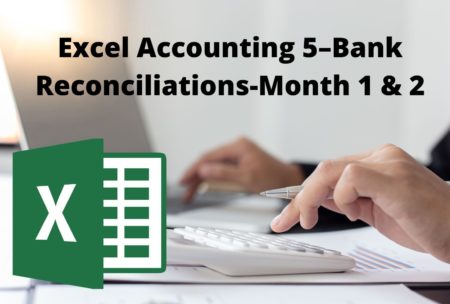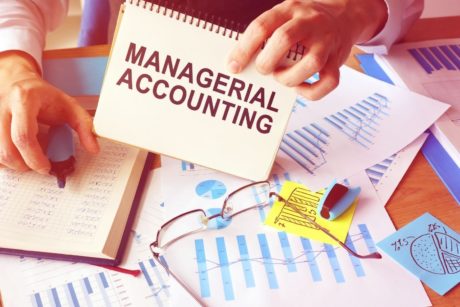Learn the basics of bank reconciliation. Read more.
Robert (Bob) Steele CPA, CGMA, M.S. Tax, CPI
Access all courses in our library for only $9/month with All Access Pass
Get Started with All Access PassBuy Only This CourseAbout This Course
Who this course is for:
- Business owners
- Accountants
- Business students
- Anyone who’d like to learn MS Excel
What you’ll learn:
- Explain why the bank reconciliation process is important
- Describe the bank reconciliation process
- Complete a bank reconciliation process after the first month of operations, explaining the problems faced often during the first bank reconciliation
- Complete a bank reconciliation after the second month of operations, explaining how the outstanding items in the first month will be included
- Define outstanding checks and how they are shown on the bank reconciliation
- Define outstanding deposits and how they are shown on the bank reconciliation
Requirements:
- No prior knowledge is required to take this course
This course will focus on creating bank reconciliations after two months of financial data was entered into an accounting system using Excel.
For most new steps in the process, you will have access to a downloadable Excel Workbook containing at least two tabs, one with the answer, the new steps completed, and the other starting where the prior presentation left off.
We will create a bank reconciliation for the first and second months.
The bank reconciliation process is one of the most important internal controls over the accounting system and also one of the most misunderstood and poorly taught procedures.
Most people think a bank reconciliation’s purpose is to double-check the ending balance of cash, and it is, in part. However, we are also verifying all the transactions that have involved cash, both increases and decreases.
Because cash is the lifeblood of the business and because every transaction will impact at least two accounts, due to the double-entry accounting system, verifying cash transactions also provides a huge internal control over the rest of the accounting system, including the revenue cycle, the expenses cycle, and the employee cycle.
Most textbook problems will teach the bank reconciliation process without providing a bank statement, which can be confusing. We will give an example bank statement we will use to perform our bank reconciliation process.
As we construct our bank reconciliation, we will discuss how accounting software, like QuickBooks, lays out the bank reconciliation process.
We will also discuss some of the problems often faced when entering the first bank reconciliation.
Our Promise to You
By the end of this course, you will have learned bank reconciliation.
10 Day Money Back Guarantee. If you are unsatisfied for any reason, simply contact us and we’ll give you a full refund. No questions asked.
Get started today!
Course Curriculum
| Section 1: Month One - Bank Reconciliation | |||
| Month One - Bank Reconciliation - Excel Worksheets | 00:00:00 | ||
| 9040 Bank Reconciliation Month One Part 1 | 00:00:00 | ||
| 9041 Bank Reconciliation Month One Part 2 | 00:00:00 | ||
| 9042 Bank Reconciliation Month One Part 3 | 00:00:00 | ||
| Section 2: Month Two - Bank Reconciliation | |||
| Month Two - Bank Reconciliation - Excel Worksheets | 00:00:00 | ||
| 9140 Bank Reconciliation Month Two Part 1 | 00:00:00 | ||
| 9141 Bank Reconciliation Month Two Part 2 | 00:00:00 | ||
| 9143 Bank Reconciliation Month Two Part 3 | 00:00:00 | ||
About This Course
Who this course is for:
- Business owners
- Accountants
- Business students
- Anyone who’d like to learn MS Excel
What you’ll learn:
- Explain why the bank reconciliation process is important
- Describe the bank reconciliation process
- Complete a bank reconciliation process after the first month of operations, explaining the problems faced often during the first bank reconciliation
- Complete a bank reconciliation after the second month of operations, explaining how the outstanding items in the first month will be included
- Define outstanding checks and how they are shown on the bank reconciliation
- Define outstanding deposits and how they are shown on the bank reconciliation
Requirements:
- No prior knowledge is required to take this course
This course will focus on creating bank reconciliations after two months of financial data was entered into an accounting system using Excel.
For most new steps in the process, you will have access to a downloadable Excel Workbook containing at least two tabs, one with the answer, the new steps completed, and the other starting where the prior presentation left off.
We will create a bank reconciliation for the first and second months.
The bank reconciliation process is one of the most important internal controls over the accounting system and also one of the most misunderstood and poorly taught procedures.
Most people think a bank reconciliation’s purpose is to double-check the ending balance of cash, and it is, in part. However, we are also verifying all the transactions that have involved cash, both increases and decreases.
Because cash is the lifeblood of the business and because every transaction will impact at least two accounts, due to the double-entry accounting system, verifying cash transactions also provides a huge internal control over the rest of the accounting system, including the revenue cycle, the expenses cycle, and the employee cycle.
Most textbook problems will teach the bank reconciliation process without providing a bank statement, which can be confusing. We will give an example bank statement we will use to perform our bank reconciliation process.
As we construct our bank reconciliation, we will discuss how accounting software, like QuickBooks, lays out the bank reconciliation process.
We will also discuss some of the problems often faced when entering the first bank reconciliation.
Our Promise to You
By the end of this course, you will have learned bank reconciliation.
10 Day Money Back Guarantee. If you are unsatisfied for any reason, simply contact us and we’ll give you a full refund. No questions asked.
Get started today!
Course Curriculum
| Section 1: Month One - Bank Reconciliation | |||
| Month One - Bank Reconciliation - Excel Worksheets | 00:00:00 | ||
| 9040 Bank Reconciliation Month One Part 1 | 00:00:00 | ||
| 9041 Bank Reconciliation Month One Part 2 | 00:00:00 | ||
| 9042 Bank Reconciliation Month One Part 3 | 00:00:00 | ||
| Section 2: Month Two - Bank Reconciliation | |||
| Month Two - Bank Reconciliation - Excel Worksheets | 00:00:00 | ||
| 9140 Bank Reconciliation Month Two Part 1 | 00:00:00 | ||
| 9141 Bank Reconciliation Month Two Part 2 | 00:00:00 | ||
| 9143 Bank Reconciliation Month Two Part 3 | 00:00:00 | ||




